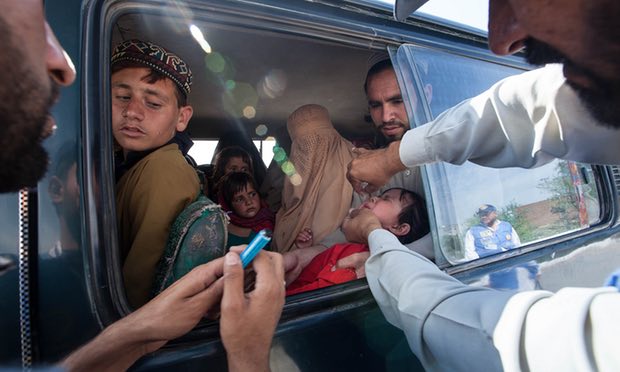
Until just a few years ago, almost all the polio cases in the world were confined to Pakistan. Now, the country is making its move to eliminate the disease from within its borders. Literally thousands of healthcare workers are giving vaccination to children at transit points across the country- from bus stops to border crossings and army posts.
The move towards zero
The move towards achieving zero polio worldwide has a rather short history- considering the period for which humans have been around on the earth. The disease was rather common among children during the early 20th century. But following the development of an injectable vaccine, its spread was brought under control in industrial nations including America and Britain during the 1950s and 60s. The fight became even more intense in 1961, thanks to the development of an oral vaccine.
However, in developing nations in Asia, Africa and Latin America, the disease still remained common. When the Global Polio Eradication Initiative began in 1988, over a thousand children were becoming victims of polio-induced paralysis every day. The WHO took the resolution to eradicate polio completely by year 2000.
Since 1988, over 2.5 billion children have been immunized against the disease. The mammoth campaign has been possible with the help of 20 million volunteers working in 200 countries. To make this possible, a global investment of $14 bn has been used.
In most of the world, the disease has been eradicated.
Africa went almost two years without a single instance of polio. But last summer, an outbreak was experienced in Nigeria which left four children paralyzed. However, since August, no new cases have been reported.
If wiped out, Polio will be only the second human-host virus to be cleared since smallpox ended in 1980.
Pakistan and Afghanistan are the final places where the virus still holds ground. A rigorous campaign is underway to make sure every child gets the vaccine.
Pakistan- turning a crisis around
Pakistan’s polio eradication efforts were in a crisis in 2014, what with frequent instances of violence against vaccinators and a crisis of faith in the political mechanism to wipe out the disease. Along with the crisis, the view that the nation was an incubator of the disease also grew in popularity. Population displacement in a massive scale also posed problems.
In 2014 alone, the total number of reported cases was 306- a rise of 93 from the year before that. In fact, in 2014, Pakistan accounted for 82% of the world’s polio cases, a newspaper editorial calling it Pakistan’s “badge of shame.”
The government then condemned the polio outbreak as a national disaster. They realized that door-to-door vaccination campaigns to immunize children were not enough anymore. The new program focused more on children who have missed the vaccination routinely. This was based on the insight that though 80% coverage was procured in every campaign, the missing 20% sustained the virus.
A refugee crisis opens an opportunity
For almost four years, from 2012 to 2015, about 5 lakh kids in the tribal areas of northwestern Pakistan were not accessible to vaccinators- most of those regions were controlled by the Taliban. And the Taliban prohibited polio vaccinations. The children in these areas were not immunized at all, triggering the 2014 outbreaks in which around 70% of the cases came from the tribal regions.
But when a military offensive drove the Taliban out in 2015, over a million civilians crossed the border and fled to Afghanistan. The ensuing refugee crisis had tens of thousands of people put in camps for the internally displaced.
The silver lining was that the crisis also helped vaccinators inoculate literally hundreds of kids who were previously inaccessible. Around 2,65,000 children were thus immunized.
Vaccinating those in transit
One of the key challenges the country faces even today is the high population movement- from migrant workers to nomads and those going to religious festivals. Over 2 lakh trained vaccinators are positioned across Quetta, Khyber Pakhtunkhawa and Karachi- the three main reservoirs of wild poliovirus.
Over 600 permanent transit posts have been installed in the country as part of the campaign. Functioning throughout the year, these kiosks give out millions of vaccinations to children and families in transit.
One of the most important stretches in the landscape to fight polio is a 2,500 km boundary between Afghanistan and Pakista- which accounts for about 90% of Pakistan’s population movement.
The two governments recently agreed to work closely in synchronized immunization campaigns. They even opened a kiosk at the Friendship Gate, a border checkpoint in Baluchistan. Aside from the migrants, about 10,000 to 15,000 traders from Afghanistan and Pakistan pass through this gate every day.
Over a thousand kids get vaccinated at the Friendship Gate every day. Thanks to the kiosk strategy, over 69 million kids have been vaccinated, who wouldn’t have been otherwise.
Among the reasons why parents refused to have their kids vaccinated are public mistrust and also intimidation by militant groups. To fight the intimidation, eight polio resource centers were opened to build community trust in high-risk areas. Since March 2014, the number of refusals has come down from 87,000 to 23,00- a refusal rate of under a percent.
The last stand
At no point in recorded history was polio’s global footprint smaller than today. In Pakistan, the number of new infections has come down from 306 in 2014 to 56 in 2015. However, refusals still happen. It’s said that about two in every 10 vehicles flagged down by vaccinators at transit points don’t participate in vaccinations.
The reasons – if the kids have already received vaccination, religious reasons or something else, remain unknown.
Image credits: guardian.com